The annatto is responsible for a persistent error, that of the existence of men with red skin. Indeed, when Christopher Columbus landed in the West Indies in 1492 he thought he was dealing with strange beings with red skin… in fact the inhabitants of these islands painted their skin with a beautiful vermilion color extracted from a plant: annatto.
This small tree, native to South America, has simple leaves, fairly large, purple or white flowers, globular red fruits, covered with prickles and which open into two valves containing many seeds, also red. These seeds are covered with a soft, sticky, resinous, vermilion red material, it is this material that constitutes annatto whose coloring component is bixin. The annatto is a key element of many Native American cultures, having at the same time aesthetic, religious, political, medical or food functions. The Europeans who discovered this plant in the West Indies then spread it to all the tropical areas where it was, and still is, used as a dye and as a medicinal plant. As a dye, annatto is used in food and textiles. In England, in Holland, in France it colors certain butters and certain cheeses; in Spain and Italy, chocolate. Until 1930, annatto was the most sought-after dye for coloring silk because it allows splendid tones: bronze, chamois, salmon, ponceau, ratine, silk yellow. It is also easy to use: a single bath is often enough to obtain the desired color. From 1859, when an 18-year-old Englishman, Perkins, invented the first artificial dye (mauveine), the use of annatto in the textile industry began to decline.
In Laos, as elsewhere, artificial colors are very widespread. However, natural dyes such as annatto are still used, particularly in the north of the country where maak saet (annatto seeds in Thai Deng dialect) are boiled in water where the dye is deposited to form, by evaporation, dyeing bars which will then be used to dye the silk.
This coloring matter also has its place in traditional medicine in Laos: it is said to have antifebrile and purgative properties. The decoction of annatto flowers is also said to be effective against dysentery and as a blood tonic.
Le roucou est responsable d’une erreur tenace, celle de l’existence d’hommes à la peau rouge. En effet lorsque Christophe Colombe débarque aux Antilles en 1492 il pense avoir affaire à des êtres étranges à la peau rouge… en fait les habitants de ces îles se peignaient la peau d’une belle couleur vermillon extraite d’une plante: le rocouyer.
Ce petit arbre, originaire d’Amérique du Sud, a des feuilles simples, des fleurs assez grandes, pourpres ou blanches, des fruits rouges globuleux, couverts d’aiguillons et qui s’ouvrent en deux valves contenant de très nombreuses graines également rouges. Ces graines sont recouvertes d’une matière molle, gluante, résineuse, d’un rouge vermillon, c’est cette matière qui constitue le rocou (ou roucou) dont la composante colorante est la bixine. Le rocou est un élément clef de nombreuses cultures amérindiennes, ayant à la fois des fonctions esthétique, religieuse, politique, médicale ou alimentaire. Les Européens qui ont découvert cette plante aux Antilles l’ont ensuite répandue dans toutes les zones tropicales où elle a été, et est toujours, utilisée comme colorant et comme plante médicinale. Comme colorant le roucou sert dans l’alimentation et dans les textiles. En Angleterre, en Hollande, en France il colore certains beurres et certains fromages; en Espagne et en Italie, le chocolat. Jusqu’en 1930, le roucou était la teinture la plus recherchée pour colorer la soie car il permet des tons splendides: mordoré, chamois, saumon, ponceau, ratine, jaune soie. Il est par ailleurs d’une utilisation facile, un seul bain suffit souvent pour obtenir la couleur souhaitée. A partir de 1859, date à laquelle un jeune Anglais de 18 ans, Perkins, invente le premier colorant artificiel (la mauveine), l’utilisation du roucou dans l’industrie textile commence à décliner.
Au Laos comme ailleurs les colorants artificiels sont très répandus. Toutefois, les teintures naturelles comme le rocou restent encore utilisées en particulier dans le Nord du pays où les maak saet (les graines de roucou en dialecte des Thai Deng) sont bouillies dans l’eau où se dépose le colorant pour former, par évaporation, des pains de teinture qui serviront ensuite à la teinture de la soie.
Cette matière colorante a aussi sa place dans la médecine traditionnelle au Laos: elle aurait des propriétés antifébriles et purgatives. La décoction des fleurs de roucou serait également efficace contre la dysenterie et comme tonique sanguin.
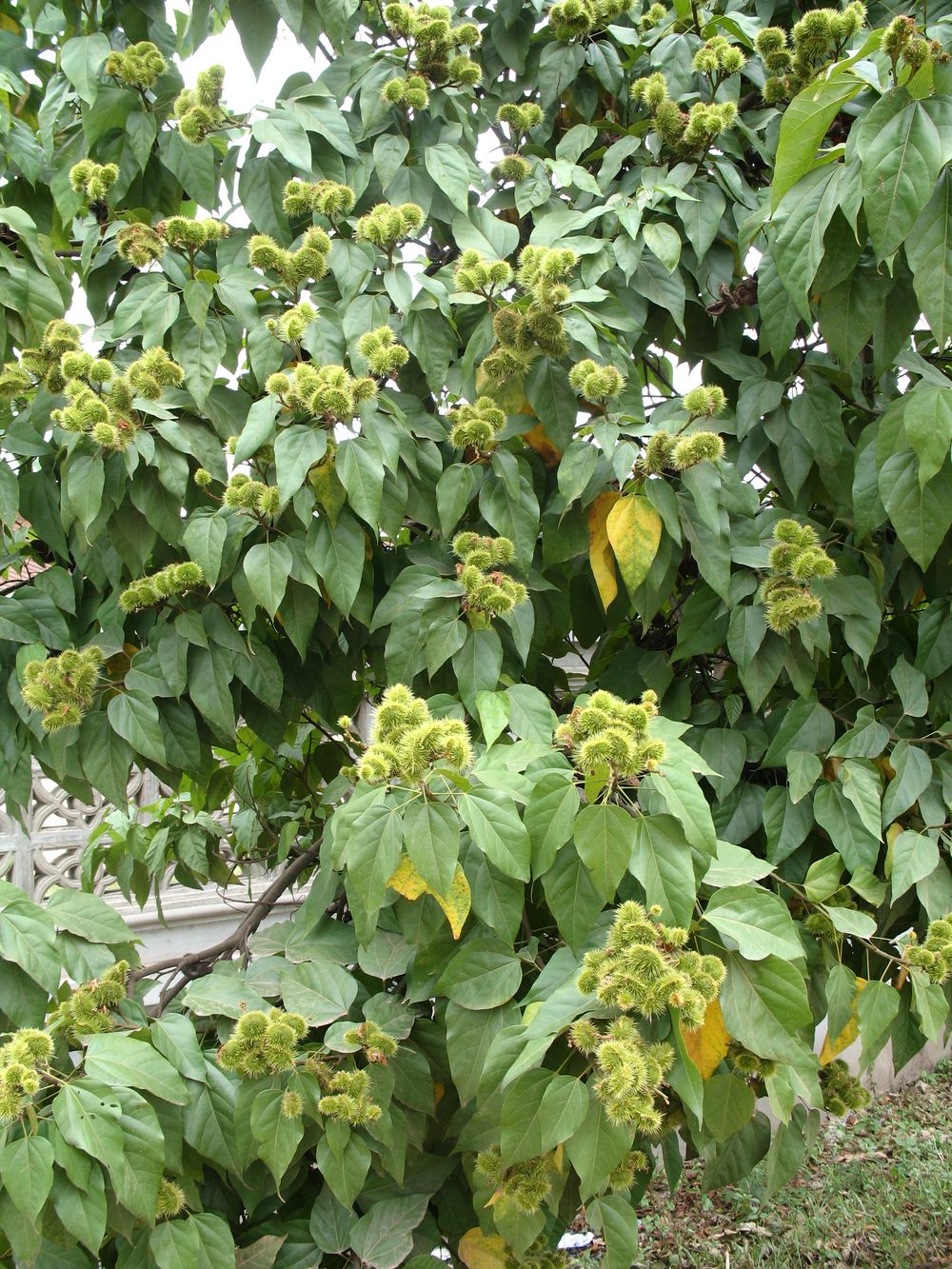
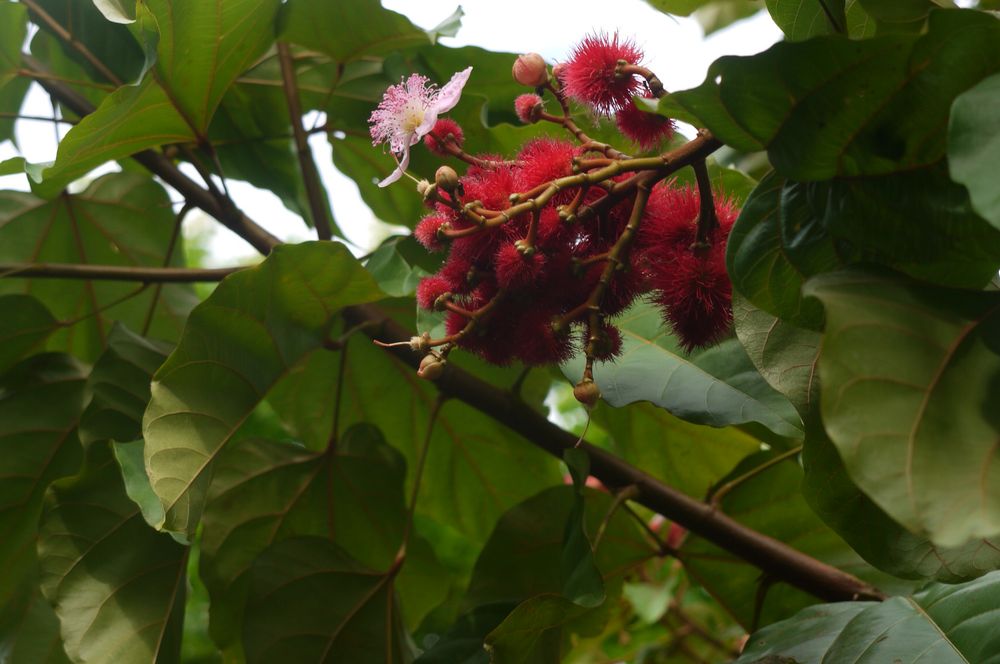
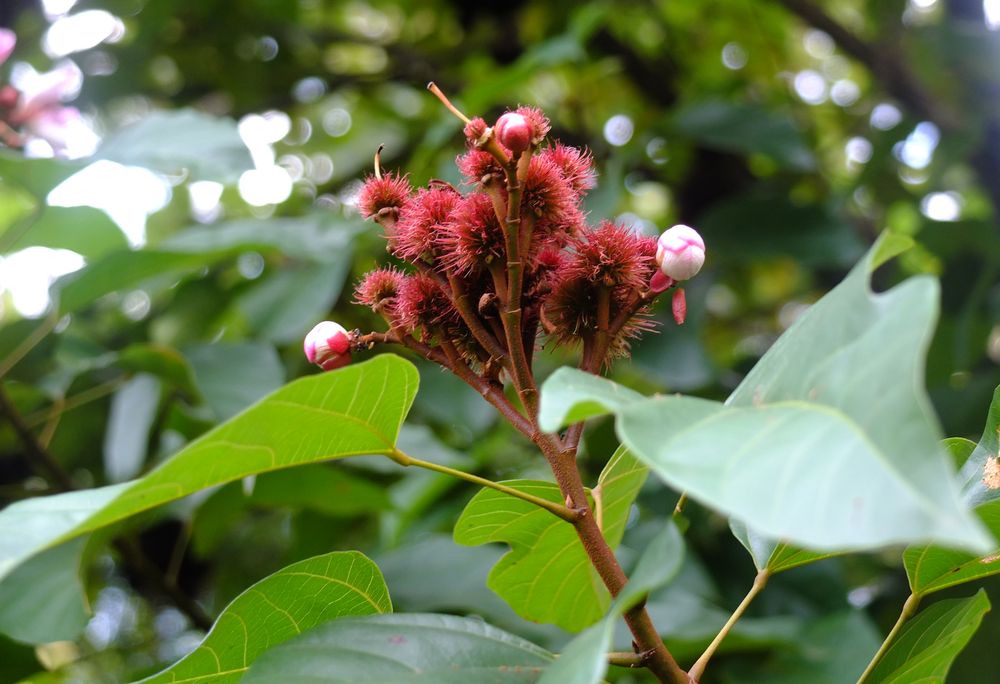
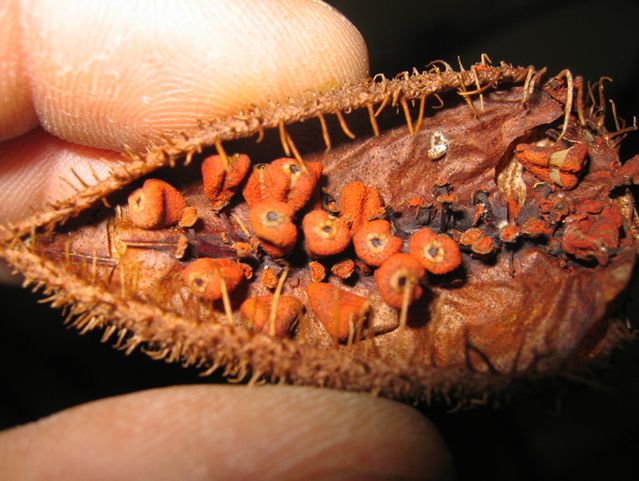
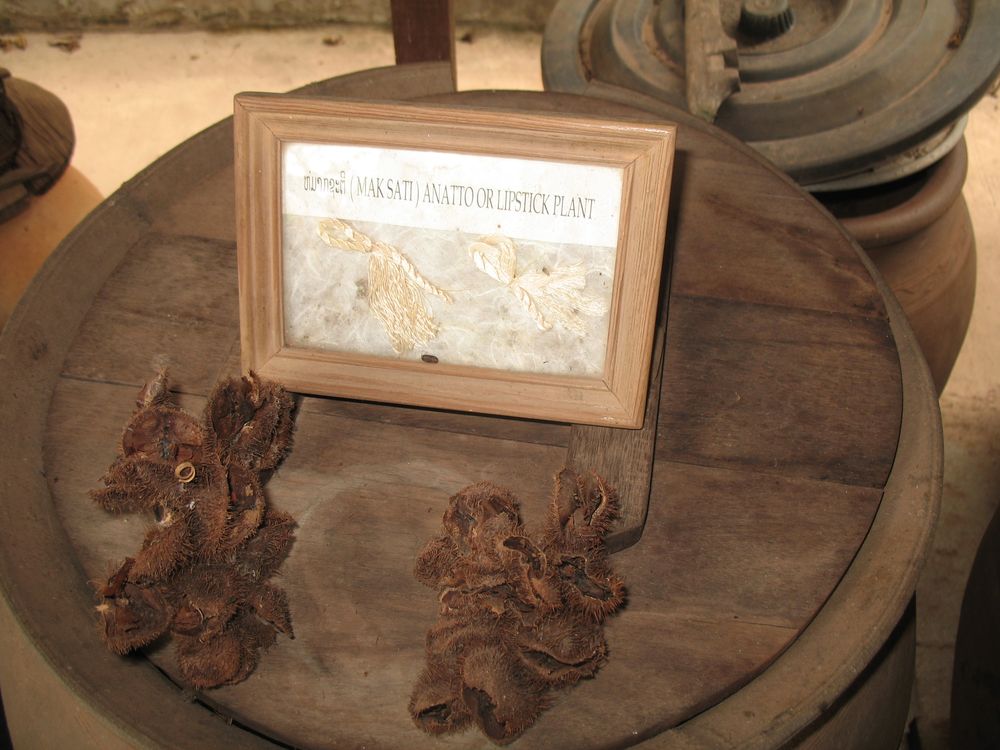
The annatto is responsible for a persistent error, that of the existence of men with red skin. Indeed, when Christopher Columbus landed in the West Indies in 1492 he thought he was dealing with strange beings with red skin… in fact the inhabitants of these islands painted their skin with a beautiful vermilion color extracted from a plant: annatto.
This small tree, native to South America, has simple leaves, fairly large, purple or white flowers, globular red fruits, covered with prickles and which open into two valves containing many seeds, also red. These seeds are covered with a soft, sticky, resinous, vermilion red material, it is this material that constitutes annatto whose coloring component is bixin. The annatto is a key element of many Native American cultures, having at the same time aesthetic, religious, political, medical or food functions. The Europeans who discovered this plant in the West Indies then spread it to all the tropical areas where it was, and still is, used as a dye and as a medicinal plant. As a dye, annatto is used in food and textiles. In England, in Holland, in France it colors certain butters and certain cheeses; in Spain and Italy, chocolate. Until 1930, annatto was the most sought-after dye for coloring silk because it allows splendid tones: bronze, chamois, salmon, ponceau, ratine, silk yellow. It is also easy to use: a single bath is often enough to obtain the desired color. From 1859, when an 18-year-old Englishman, Perkins, invented the first artificial dye (mauveine), the use of annatto in the textile industry began to decline.
In Laos, as elsewhere, artificial colors are very widespread. However, natural dyes such as annatto are still used, particularly in the north of the country where maak saet (annatto seeds in Thai Deng dialect) are boiled in water where the dye is deposited to form, by evaporation, dyeing bars which will then be used to dye the silk.
This coloring matter also has its place in traditional medicine in Laos: it is said to have antifebrile and purgative properties. The decoction of annatto flowers is also said to be effective against dysentery and as a blood tonic.
Le roucou est responsable d’une erreur tenace, celle de l’existence d’hommes à la peau rouge. En effet lorsque Christophe Colombe débarque aux Antilles en 1492 il pense avoir affaire à des êtres étranges à la peau rouge… en fait les habitants de ces îles se peignaient la peau d’une belle couleur vermillon extraite d’une plante: le rocouyer.
Ce petit arbre, originaire d’Amérique du Sud, a des feuilles simples, des fleurs assez grandes, pourpres ou blanches, des fruits rouges globuleux, couverts d’aiguillons et qui s’ouvrent en deux valves contenant de très nombreuses graines également rouges. Ces graines sont recouvertes d’une matière molle, gluante, résineuse, d’un rouge vermillon, c’est cette matière qui constitue le rocou (ou roucou) dont la composante colorante est la bixine. Le rocou est un élément clef de nombreuses cultures amérindiennes, ayant à la fois des fonctions esthétique, religieuse, politique, médicale ou alimentaire. Les Européens qui ont découvert cette plante aux Antilles l’ont ensuite répandue dans toutes les zones tropicales où elle a été, et est toujours, utilisée comme colorant et comme plante médicinale. Comme colorant le roucou sert dans l’alimentation et dans les textiles. En Angleterre, en Hollande, en France il colore certains beurres et certains fromages; en Espagne et en Italie, le chocolat. Jusqu’en 1930, le roucou était la teinture la plus recherchée pour colorer la soie car il permet des tons splendides: mordoré, chamois, saumon, ponceau, ratine, jaune soie. Il est par ailleurs d’une utilisation facile, un seul bain suffit souvent pour obtenir la couleur souhaitée. A partir de 1859, date à laquelle un jeune Anglais de 18 ans, Perkins, invente le premier colorant artificiel (la mauveine), l’utilisation du roucou dans l’industrie textile commence à décliner.
Au Laos comme ailleurs les colorants artificiels sont très répandus. Toutefois, les teintures naturelles comme le rocou restent encore utilisées en particulier dans le Nord du pays où les maak saet (les graines de roucou en dialecte des Thai Deng) sont bouillies dans l’eau où se dépose le colorant pour former, par évaporation, des pains de teinture qui serviront ensuite à la teinture de la soie.
Cette matière colorante a aussi sa place dans la médecine traditionnelle au Laos: elle aurait des propriétés antifébriles et purgatives. La décoction des fleurs de roucou serait également efficace contre la dysenterie et comme tonique sanguin.










The annatto is responsible for a persistent error, that of the existence of men with red skin. Indeed, when Christopher Columbus landed in the West Indies in 1492 he thought he was dealing with strange beings with red skin… in fact the inhabitants of these islands painted their skin with a beautiful vermilion color extracted from a plant: annatto.
This small tree, native to South America, has simple leaves, fairly large, purple or white flowers, globular red fruits, covered with prickles and which open into two valves containing many seeds, also red. These seeds are covered with a soft, sticky, resinous, vermilion red material, it is this material that constitutes annatto whose coloring component is bixin. The annatto is a key element of many Native American cultures, having at the same time aesthetic, religious, political, medical or food functions. The Europeans who discovered this plant in the West Indies then spread it to all the tropical areas where it was, and still is, used as a dye and as a medicinal plant. As a dye, annatto is used in food and textiles. In England, in Holland, in France it colors certain butters and certain cheeses; in Spain and Italy, chocolate. Until 1930, annatto was the most sought-after dye for coloring silk because it allows splendid tones: bronze, chamois, salmon, ponceau, ratine, silk yellow. It is also easy to use: a single bath is often enough to obtain the desired color. From 1859, when an 18-year-old Englishman, Perkins, invented the first artificial dye (mauveine), the use of annatto in the textile industry began to decline.
In Laos, as elsewhere, artificial colors are very widespread. However, natural dyes such as annatto are still used, particularly in the north of the country where maak saet (annatto seeds in Thai Deng dialect) are boiled in water where the dye is deposited to form, by evaporation, dyeing bars which will then be used to dye the silk.
This coloring matter also has its place in traditional medicine in Laos: it is said to have antifebrile and purgative properties. The decoction of annatto flowers is also said to be effective against dysentery and as a blood tonic.
Le roucou est responsable d’une erreur tenace, celle de l’existence d’hommes à la peau rouge. En effet lorsque Christophe Colombe débarque aux Antilles en 1492 il pense avoir affaire à des êtres étranges à la peau rouge… en fait les habitants de ces îles se peignaient la peau d’une belle couleur vermillon extraite d’une plante: le rocouyer.
Ce petit arbre, originaire d’Amérique du Sud, a des feuilles simples, des fleurs assez grandes, pourpres ou blanches, des fruits rouges globuleux, couverts d’aiguillons et qui s’ouvrent en deux valves contenant de très nombreuses graines également rouges. Ces graines sont recouvertes d’une matière molle, gluante, résineuse, d’un rouge vermillon, c’est cette matière qui constitue le rocou (ou roucou) dont la composante colorante est la bixine. Le rocou est un élément clef de nombreuses cultures amérindiennes, ayant à la fois des fonctions esthétique, religieuse, politique, médicale ou alimentaire. Les Européens qui ont découvert cette plante aux Antilles l’ont ensuite répandue dans toutes les zones tropicales où elle a été, et est toujours, utilisée comme colorant et comme plante médicinale. Comme colorant le roucou sert dans l’alimentation et dans les textiles. En Angleterre, en Hollande, en France il colore certains beurres et certains fromages; en Espagne et en Italie, le chocolat. Jusqu’en 1930, le roucou était la teinture la plus recherchée pour colorer la soie car il permet des tons splendides: mordoré, chamois, saumon, ponceau, ratine, jaune soie. Il est par ailleurs d’une utilisation facile, un seul bain suffit souvent pour obtenir la couleur souhaitée. A partir de 1859, date à laquelle un jeune Anglais de 18 ans, Perkins, invente le premier colorant artificiel (la mauveine), l’utilisation du roucou dans l’industrie textile commence à décliner.
Au Laos comme ailleurs les colorants artificiels sont très répandus. Toutefois, les teintures naturelles comme le rocou restent encore utilisées en particulier dans le Nord du pays où les maak saet (les graines de roucou en dialecte des Thai Deng) sont bouillies dans l’eau où se dépose le colorant pour former, par évaporation, des pains de teinture qui serviront ensuite à la teinture de la soie.
Cette matière colorante a aussi sa place dans la médecine traditionnelle au Laos: elle aurait des propriétés antifébriles et purgatives. La décoction des fleurs de roucou serait également efficace contre la dysenterie et comme tonique sanguin.


